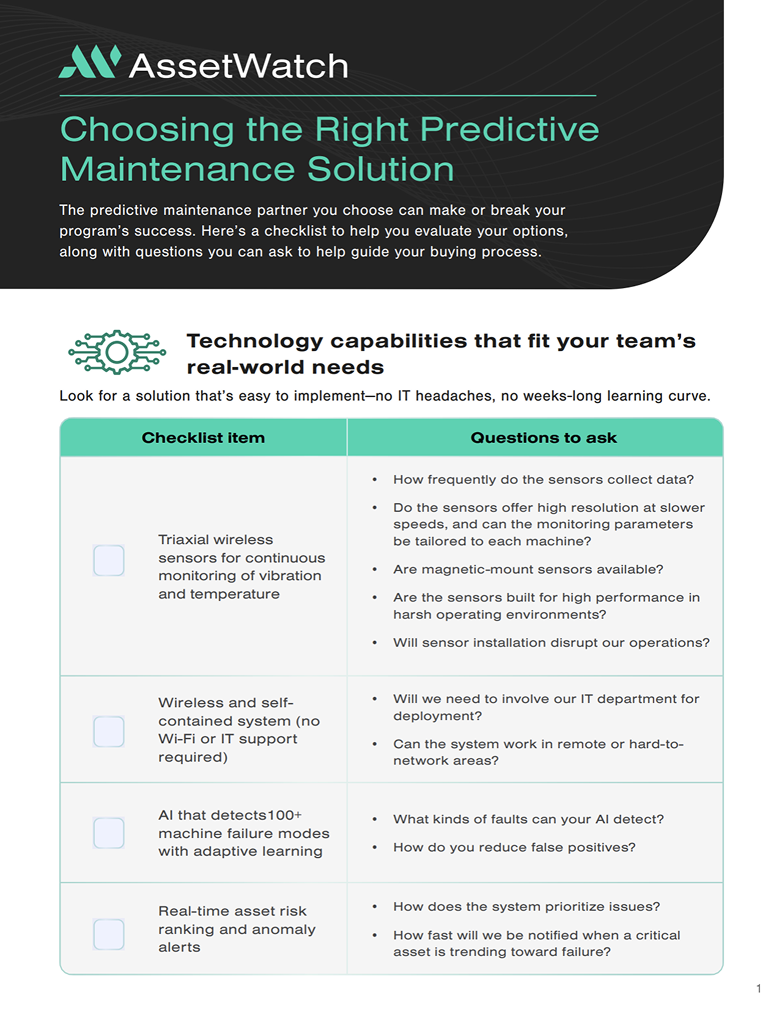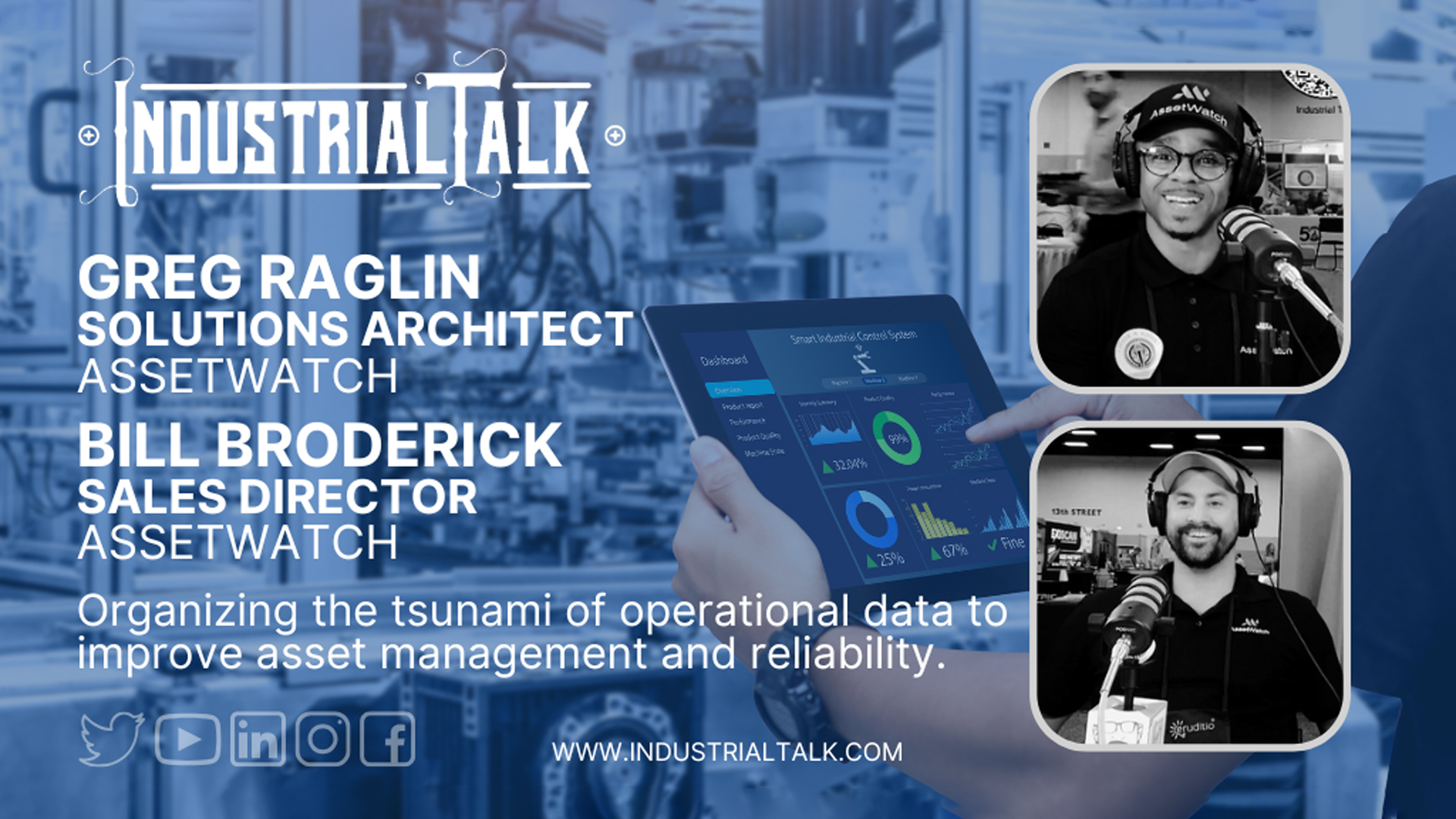If you're ready to end the chaos of reactive maintenance and implement a predictive maintenance solution, you're ahead of the curve already. The question now is, how will you move from intention to execution?
Implementing predictive maintenance (PdM) isn't just a matter of bringing technology online. It's a strategic shift with a huge ripple effect, both operational and human. It's important to get the introduction to this new predictive strategy right—to make it work with your existing setup so you can empower your people to win.
This guide will help you integrate PdM software and tools into your existing maintenance strategy without missing a beat. You’ll learn how to assess your current maintenance program, build the right team, select software solutions, and streamline the predictive maintenance process using real-time data and condition monitoring.
1. Assess Predictive Maintenance Readiness: Where Are You Today?
Before you implement predictive maintenance software or technologies, you need a clear picture of your current maintenance strategy. A maintenance maturity audit helps you assess where you are, identify what's missing, and build a solid foundation for predictive success.
This step is critical, because it ensures you don’t implement advanced technologies into a system that’s not ready to use them effectively. It also helps to narrow the field of solution options by revealing the level of support you'll need to get up and running and to help your team make a smooth transition. A full-service provider can help walk you through this process, step by step.
Current Maintenance Strategy
What to assess
Determine whether your approach is primarily reactive, preventive, or a blend. Look at the ratio of unplanned vs. planned work orders and how frequently your team deals with breakdowns.
Why it matters
Predictive maintenance strategies perform best in environments that already have some structure. If your maintenance team is constantly firefighting, you’ll struggle to act on real-time predictive alerts. This step helps clarify whether foundational improvements—like better scheduling or preventive routines—are needed before you implement predictive maintenance.
Asset Inventory and Criticality
What to assess
Ensure you have a current, accurate list of all critical assets, including nameplate data, maintenance history, and failure impact. Include how each asset ties to production goals, quality, safety, or compliance.
Why it matters
A criticality assessment helps your maintenance organization categorize machines so you can invest in a cost-conscious way while maximizing your ability to prevent downtime. Without clear asset criticality, you risk wasting money monitoring low-impact machines while overlooking those that can derail production during failure.
Predictive maintenance is most impactful when applied to high-risk or high-cost assets first. Starting with high-priority assets means you’ll see faster ROI, optimized maintenance activities, and increased confidence in predictive maintenance capabilities. The right balance of continuous and route-based condition monitoring can optimize both coverage and savings.
Condition Monitoring Capabilities
What to assess
Take stock of your existing condition monitoring tools (e.g., vibration analysis, temperature, oil analysis), how often they’re used, and by whom. Note whether they’re manual, route-based, or continuous, and whether the data is stored or analyzed.
Why it matters
Predictive maintenance uses condition data as its fuel. If you don’t already collect reliable condition data—or if it’s stuck in static PDFs—your predictive maintenance solution won’t have the visibility it needs to generate accurate, real-time insights.
Maintenance Data Quality and History
What to assess
Review your CMMS or maintenance software to see how work orders are logged, closed, and categorized. Check for complete, standardized entries (including failure codes, parts used, and repair notes) and ensure asset histories are trackable.
Why it matters
Machine learning models and predictive algorithms require good data to be effective. Incomplete or inconsistent maintenance records can lead to false positives, missed alerts, and inaccurate predictive analytics.
Maintenance Software and System Integration
What to assess
Look at your current maintenance software stack. Does your CMMS track asset histories? Can it integrate with real-time condition monitoring platforms? Is it actively used by your maintenance technicians?
Why it matters
To implement predictive maintenance without disruption, your predictive maintenance tools must integrate seamlessly with your existing maintenance software and management systems. The goal is to automate—not duplicate—maintenance workflows.
The maintenance maturity audit ensures you're building your predictive maintenance strategy on a stable foundation. Skipping this step risks poor adoption, unreliable results, and wasted investment. Done right, the audit helps you prioritize improvements, choose the right predictive maintenance solution, and tailor your rollout to the real needs and readiness level of your organization.
2. Choose KPIs to Track Predictive Maintenance Outcomes
One of the key benefits of predictive maintenance is better visibility into your performance. You can expect to see measurable progress across the board, from increased cost savings and higher productivity to safety and sustainability improvements. The predictive maintenance KPIs you select should reflect both operational and financial gains.
Some of the most commonly tracked PdM KPIs include:
- Mean time between failures (MTBF)
- Mean time to repair (MTTR)
- Overall equipment effectiveness (OEE)
- Capacity utilization
- Throughput increase
- Total cost of maintenance (TCM)
Advanced analytics in predictive maintenance software solutions help visualize performance over time and pinpoint opportunities to reduce maintenance costs further while enhancing equipment health and lifespan.
Get a complete list of KPIs you can use to make a business case for PdM technologies and to drive operational gains over time. Download your copy here.
3. Assemble a Predictive Maintenance Team with Clear Roles
Predictive maintenance requires cross-functional coordination. Each function brings a unique perspective and skill set critical to making the system work. You need a team aligned around shared goals, trained in their responsibilities, and ready to act on predictive insights.
Here's the makeup of a robust predictive maintenance team that works smarter, not harder, and accomplishes more with less:
Maintenance manager: program lead and KPI owner
Defines the vision for implementation, oversees the transition from reactive to predictive, ensures KPIs are defined and tracked, and advocates for team training and resource allocation
Reliability engineer: data analyst and technical expert
Tracks the data, identifies anomalies, recommends appropriate maintenance tasks, and documents asset health trends and predictive analysis
IT lead or systems engineer: systems integrator and data security gatekeeper
Facilitates the integration of PdM software with CMMS and ERP platforms, oversees network security and permissions, supports device configuration, and advises on scalability and support plans
Operations supervisor: workflow coordinator and downtime strategist
Approves scheduled maintenance based on production timelines, collaborates on planned downtime, provides input on PdM's impact on throughput, and ensures streamlined communications between maintenance and operations
Predictive maintenance champion: cultural leader and change advocate
Promotes the benefits of PdM internally, helps onboard maintenance technicians, reinforces process changes, highlights early wins to build buy-in, and ensures predictive tools become embedded in daily workflows
An expert CME partner who operates as an extension of your team—as part of a full-service condition monitoring program—can help smooth the transition to predictive, prevent alert fatigue, and provide prescriptive guidance that improves maintenance outcomes. Provider support should also include ongoing system maintenance as well as guidance on scaling your PdM program.
4. Select the Right Predictive Maintenance Software and Tools
When selecting predictive maintenance technologies, make sure they support your team, assets, and infrastructure. Make sure your provider does, too, by offering dedicated expert support as part of an end-to-end condition monitoring solution. Essential features include:
- Vibration monitoring, oil analysis, and temperature data capture
- AI-driven predictive maintenance algorithms that identify early-stage faults
- Machine learning insights to support ongoing predictive analytics
- Condition dashboards with real-time data visibility
- Seamless CMMS integration to automate maintenance work orders and track to closure
- No-hassle 1-2 day deployment that doesn't require IT overhead or involvement
The most cost-effective solution delivers PdM capabilities through a fully managed subscription service—one that includes wireless sensors, cloud-based monitoring, expert analysis, and predictive data insights—bundled together with zero CapEx investment.
5. Define the Predictive Maintenance Workflow
A consistent, effective predictive maintenance process clearly defines how insights become action. By standardizing your maintenance process and using predictive maintenance tools with built-in workflows, your team can react quickly and confidently to avoid downtime.
An optimized predictive maintenance workflow looks like this:
- Monitoring: Real-time vibration and temperature data stream through sensors and software 24/7
- AI Analysis: Predictive models and analytics flag condition anomalies
- Human Review: Your provider's CME, dedicated to your facility, validates insights to filter out false positives
- Maintenance alerts: Your CME provides your maintenance team with prescriptive insights
- Work execution: Work orders are automated through the CMMS, with repairs scheduled at the optimal time to prevent failure
- Closeout: Maintenance records are automatically updated for future analysis
A well-defined predictive maintenance workflow creates the operational backbone of your entire program. When every team member knows their role, every step is traceable, and every response is timely, the stage is set for long-term success.
Equally important, a standardized workflow makes predictive maintenance scalable. You'll be able to expand across assets, lines, and sites without sacrificing consistency or results.
6. Address Common Predictive Maintenance Challenges Through Training
Predictive maintenance requires a cultural shift from reacting to problems to preventing them. And that's no small feat. You'll need to help your team overcome resistance to change and/or skepticism toward new technologies to get their buy-in. If you move forward without it, even the best predictive maintenance software can't deliver the long-term value you're looking for.
Successful change management involves:
- Training maintenance personnel on predictive maintenance technologies
- Providing hands-on support to maintenance technicians and engineers
- Documenting processes for analyzing condition and vibration data
- Showcasing early wins to build trust in predictive maintenance strategies
With a full-service provider, you'll have three major advantages to help with this process. First, you'll have an expert team guiding you step by step, from the initial criticality assessment and install to acclimating your team to new features and capabilities. Second, you'll have a dedicated CME who will validate the data and reach out with actionable insights, making it easy for your team to focus on maintenance priorities. Third, with ongoing visibility into asset health and early detection and resolution of emerging issues, your team will start to see value right out of the gate.
Early predictive maintenance wins can convince even the most reluctant members of the team. The City of Tulsa discovered this after implementing condition monitoring and predictive analytics—when their first asset save during a trial period covered two years of service. Read the success story here.
7. Use Predictive Maintenance to Optimize Maintenance Schedules
The most effective predictive maintenance enables dynamic maintenance scheduling. Instead of relying on preventive maintenance intervals, you can use real-time condition monitoring and machine learning to optimize maintenance schedules based on actual equipment condition. Follow these steps to establish a smarter, condition-driven scheduling strategy.
- Segment assets by condition and risk: Group your assets by current condition, failure impact, and lead time for parts or repairs.
- Build a dynamic maintenance planning calendar: Factor in real-time condition data, alerts, technician availability, and upcoming production windows or planned downtime.
- Automate the handoff from insight to work order: Define clear rules for who receives the alert, which work order templates apply to which failure modes, and escalation procedures if maintenance isn't scheduled in time.
- Review and adjust weekly: Hold short scheduling meetings to confirm work orders align with asset condition trends, review technician availability and shift changes, adjust for unexpected production demands, and flag any open alerts that haven't been scheduled.
It's also important to analyze schedule effectiveness over time by measuring on-time maintenance completion rates, the ratio of planned vs. unplanned work, downtime avoided, and time between alert and repair. This will allow you to continue refining your scheduling and demonstrate your predictive maintenance ROI.
8. Measure Success and Scale Your Predictive Maintenance Program
After you implement predictive maintenance, continuously evaluate its performance. Use your defined KPIs to track improvements in downtime, equipment reliability, and cost savings. Look for patterns in predictive analytics that support scaling your predictive maintenance systems across additional assets.
As your PdM processes improve, so does your ability to predict future needs, reduce unnecessary maintenance, and transform your facility's approach to asset management.
Key Takeaways: How to Implement a Predictive Maintenance Program with Confidence
✅ Conduct a maintenance maturity audit and criticality assessment
✅ Define KPIs to track predictive maintenance performance
✅ Build a cross-functional predictive maintenance team
✅ Choose the right predictive maintenance software
✅ Define a scalable predictive maintenance process
✅ Prioritize training and change management
✅ Let real-time data and predictive analytics guide your strategy
With the right foundation, predictive maintenance software solutions can transform your maintenance strategy, reduce equipment failure, and give your team the clarity they need to work smarter, not harder.
Interested in learning more about setting the stage for predictive maintenance success? Watch this brief Noria video, "3 Things You Need to Get Started with Condition Monitoring," and hear expert takes on the early foundational steps you need to succeed.




.webp)













